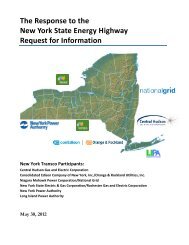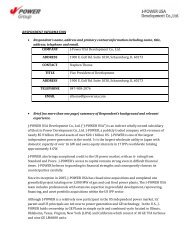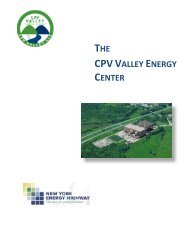Silicon Solution Joint Venture, LLC - Energy Highway
Silicon Solution Joint Venture, LLC - Energy Highway
Silicon Solution Joint Venture, LLC - Energy Highway
Create successful ePaper yourself
Turn your PDF publications into a flip-book with our unique Google optimized e-Paper software.
US SOLAR – WHITE PAPER 24 May 2012<br />
Information Administration forecasts US energy consumption of 4,172TWh by the end of the<br />
decade, of which we expect PV generation to supply 1%.<br />
Figure 7 projects US PV annual demand for third-party tax equity financing. The sudden spike in<br />
2012 results from the expiration of the cash grant and the revival of the ITC. The 2017 drop-off in<br />
required tax equity results from the 30% ITC reducing to a 10% credit, as per current policy. A<br />
change in policy, extending the 30% ITC beyond 2016, would result in a strong uptick both in<br />
project cumulative PV installations and tax equity requirements for 2017–20.<br />
Figure 6: Historical and projected cumulative US PV<br />
capacity installed (GW)<br />
35<br />
Figure 7: Historical and projected need for third-party tax<br />
equity financing for US PV ($bn)<br />
3.0<br />
30<br />
25<br />
20<br />
15<br />
10<br />
5<br />
2.5<br />
2.0<br />
1.5<br />
1.0<br />
0.5<br />
MACRS<br />
ITC<br />
0<br />
0.0<br />
2007<br />
2008<br />
2009<br />
2010<br />
2011<br />
2012<br />
2013<br />
2014<br />
2015<br />
2016<br />
2017<br />
2018<br />
2019<br />
2020<br />
2007<br />
2008<br />
2009<br />
2010<br />
2011<br />
2012<br />
2013<br />
2014<br />
2015<br />
2016<br />
2017<br />
2018<br />
2019<br />
2020<br />
Source: Bloomberg New <strong>Energy</strong> Finance Notes: Solar growth projections based on Bloomberg New <strong>Energy</strong> Finance analysis. ITC analysis<br />
assumes 100% of projects financed in 2009-2011 took advantage of cash grant; 30% ITC through 2016, 10% ITC after 2016. MACRS historical<br />
and projections are based on average ratio between MACRS value and ITC for a typical project – or, in the case of 2009-2011, based on MACRS<br />
value per MW for a typical project. Value of MACRS calculated as increase in NPV relative to straight-line.<br />
PV capital requirements<br />
for 2012–20 total $62bn,<br />
of which $12bn is<br />
required third-party tax<br />
equity<br />
The rise of distributed<br />
solar has led to the<br />
creation of new and<br />
diverse business models<br />
PV capital requirements for 2012–20 total $62bn, of which $12bn is required third-party tax equity.<br />
New business models, new investors, and new vehicles to harness that investment will help meet<br />
that need.<br />
3. BUSINESS MODELS<br />
3.1. Types of models for solar deployment<br />
Utilities and IPPs are accustomed to building and integrating power plants that operate at large<br />
scale. The rise of distributed solar has led to the creation of new and diverse business models,<br />
popularised by third-party financiers such as SolarCity and Sunrun and intermediaries such as<br />
Clean Power Finance. This section describes the various models used across the solar industry.<br />
Table 1 provides descriptions and examples of the various solar business model participants and<br />
is colour-coded to correspond with Figures 8-11.<br />
Utility-scale PPA model<br />
Project developers and financiers have traditionally operated under a common and relatively<br />
simple project finance model in which a developer invests sponsor equity into a project and a<br />
lender provides non-recourse project debt (Figure 8). In the renewable energy sector, a tax equity<br />
investor can also provide financing if a developer cannot monetise the renewable tax benefits,<br />
including the ITC. With this capital, a developer can build a project and sell electricity into the<br />
merchant market, or directly to a utility via a power purchase agreement (PPA).<br />
© Bloomberg New <strong>Energy</strong> Finance 2012<br />
Strictly no copying, forwarding, shared passwords or redistribution allowed without prior written permission<br />
of Bloomberg New <strong>Energy</strong> Finance. For more information on terms of use, please contact<br />
sales.bnef@bloomberg.net. Copyright and Disclaimer notice on page 28 applies throughout. Page 5 of 28














